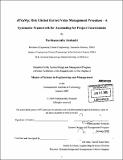rEVaMp : Risk Elicited Earned Value Management procedure -- A systematic framework for accounting for project uncertainties
Author(s)
Seshadri, Parthasarathy
DownloadFull printable version (23.16Mb)
Alternative title
Risk Elicited Earned Value Management procedure
Systematic framework for accounting for project uncertainties
Other Contributors
System Design and Management Program.
Advisor
Pat Hale.
Terms of use
Metadata
Show full item recordAbstract
Background: Project and program budget estimation and execution within the estimated budget are critical functions in any organization, in particular those dealing with fixed cost contracts. During planning, the functional organization estimates the baseline cost and schedule by considering the project as a number of interacting tasks and rolling up resource estimates for completing these tasks and the senior management allocate contingency or management reserve to account for project risks. During execution, project organization measures the project performance against the baseline cost and schedule to prevent cost overruns. One of the methods for monitoring project performance is the Earned Value Management (EVM) methodology which uses conceptually simple parameters like Cost Performance Index (CPI) and Schedule Performance Index (SPI) to monitor and articulate project performance and to compute estimated cost at completion (EAC). Motivation: The budgeting approach as outlined above does not explicitly account for emerging project uncertainties and as a result contingency allocated by the organization at the planning stage may not be sufficient, as the allocation is based on prior experience and does not take the impact of the emerging risk on the project into account. During planning differences in perceptions of risks with regards to requirements, work scope, maturity of technology, engineering effort and organizational capacity introduce uncertainties. (cont.) During execution, uncertainties emanate from emerging risks, utilization of past performance to predict EAC and assignment of "earned value" to partially completed tasks. Accounting for these uncertainties could result in a wide range of valid EAC values each associated with a unique likelihood (probability or confidence level). From a project risk management perspective, establishing and constantly monitoring this 'likelihood' value will help organizations to accurately measure performance and proactively implement risk mitigation strategies to keep the project in check and to clearly articulate project performance status across the organization. Approach: This thesis extends EVM for incorporating uncertainties and establishing parameters for articulating project performance in a systematic manner. During project planning "Risk Elicited Earned Value Management Procedure" systematically captures embedded costing assumptions and quantifies the impact of task level uncertainties to determine the likelihood of a project meeting the baseline cost using Monte Carlo methodology; such risk quantification will help organizations in contingency allocation for addressing known risks and unknown risks. In this thesis, total contingency amount will be split into two parts - hard and soft values. The hard management reserve (HMR) allocated by the senior management is primarily for addressing known risks and soft management reserve (SMR) is primarily for addressing any unknown risks that typically emerges during the course of project execution. (cont.) The senior management would also like to challenge the organization to improve its performance by not completely funding the project but would like to know its impact on the likelihood so as to prevent unduly burdening the organization. During execution, the same risk elicitation procedure can be used to estimate the likelihood that a project meets the EAC calculated by EVM and in addition, establish what it would take to meet the challenge imposed by the management. Additional emerging risks and refinement in risk mitigation strategies can be incorporated to improve the confidence level on the estimated likelihood. In essence, the new procedure provides a systematic framework for deliberations between functional and project organizations in developing a robust risk management strategy and the likelihood can be used to articulate project status to senior management. Results: The case studies indicated that the risk elicited approach yields additional parameters that would allow the organization to evaluate the impact of the underlying risk profile and project performance on cost and schedule and help establish confidence levels on the estimated cost and schedule. The approach also helps benchmark organizational performance against management expectations. Conclusions: The systematic risk elicitation approach outlined in this thesis improves the process of project cost estimation and project execution by making the process more transparent and instilling accountability across the organization. (cont.) This transparency ensures that the entire organization - functional, project and senior management have the same understanding about costing methodology. The process establishes confidence levels on the estimated cost and schedule at completion which were not available to the organization previously. This additional information will help the organization with prioritizing risks, securing allocation of adequate funding and contingency amounts and assuring the senior management that the organization is not unduly challenged minimizing employee frustration and burn-out. The framework provides a quantitative means to compare the effect of emerging risks and mitigation plans on project performance. The case studies also demonstrated that the approach has the ability to indicate problems even at the project planning stage by establishing confidence levels that can be used to evaluate robustness of project costing and articulate status of the project during its execution in an objective manner.
Description
Thesis (S.M.)--Massachusetts Institute of Technology, System Design and Management Program, 2009. Includes bibliographical references (leaves 97-98).
Date issued
2009Department
System Design and Management Program.Publisher
Massachusetts Institute of Technology
Keywords
System Design and Management Program.